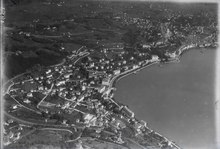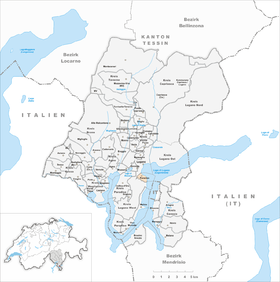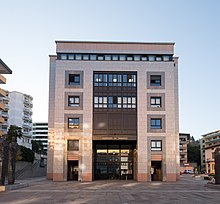Paradiso TI
| TI is the abbreviation for the canton of Ticino in Switzerland and is used to avoid confusion with other entries of the name Paradiso . |
| Paradiso | |
|---|---|
| State : |
|
| Canton : |
|
| District : | Lugano district |
| Circle : | Paradiso district |
| BFS no. : | 5210 |
| Postal code : | 6900 |
| Coordinates : | 716 692 / 94395 |
| Height : | 274 m above sea level M. |
| Height range : | 270–640 m above sea level M. |
| Area : | 0.89 km² |
| Residents: | 4247 (December 31, 2018) |
| Population density : | 4772 inhabitants per km² |
|
Proportion of foreigners : (residents without citizenship ) |
54.4% (December 31, 2,013) |
| Website: | www.comune-paradiso.ch |
|
Paradiso TI |
|
| Location of the municipality | |
Paradiso (until 1929 Calprino ) is a municipality in the district of Paradiso , district Lugano , in the Swiss canton of Ticino .
geography

Paradiso is located on Lake Lugano at the foot of Monte San Salvatore . The municipality bordering Lugano merges seamlessly into this and is therefore often mistakenly viewed as just a district of Lugano. Paradiso has an international maritime border with the Italian exclave and municipality of Campione d'Italia .
History and place name
The municipality has only been called Paradiso since 1929 , before that it was called Calprino for centuries . The fractions Calprino (on the north slope of San Salvatore), Fontana (on the lake) and Guidino (also on the north slope of San Salvatore, but east of Calprino) are first attested from the 12th to the 14th centuries; the Paradiso fraction, also located on the lake, was first mentioned in 1713 as "Paradiso di Fontana".
population
| Population development | ||||||||||||||
|---|---|---|---|---|---|---|---|---|---|---|---|---|---|---|
| year | 1850 | 1900 | 1950 | 1970 | 1980 | 1990 | 2000 | 2005 | 2010 | 2018 | ||||
| Residents | 254 | 791 | 1660 | 3101 | 3261 | 3372 | 3694 | 3524 | 3454 | 4247 | ||||
Economy and Transport
Until the middle of the 20th century, Paradiso, with its hotels on the waterfront, was a quiet place to relax compared to busy Lugano. Initially the site was by the tram operated Lugano, on the now also set trolley Lugano followed. Meanwhile, Paradiso and Lugano are connected by a bus line. There is also a boat connection to the Debarcadero Centrale in Lugano (the main landing stage) as well as a two kilometer long, scenic footpath, the «Lungolago».
Paradiso was not only determined by hotels, but also by numerous villas on a hillside (e.g. Villa Mersmann), behind which the Paradiso train station was set up at the same time the Gotthard Railway opened. The shore road runs from Paradiso along the lake, below the rock walls of Monte San Salvatore, after the Ponte Diga, the bridge to the east bank. There in Bissone there is a junction to Campione d'Italia , an Italian enclave with a well-known casino. Main road, motorway and train now run largely parallel to Chiasso , the Swiss-Italian border town. Before the pier near Melide , the western lakeshore road turns to the old trading center and fishing village of Morcote .
Since 1980, Paradiso has been relieved of heavy through traffic in sections by building the motorway, which, starting from Paradiso Centro, tunnels under Monte San Salvatore to Ponte Diga and connects the Swiss motorway network with the Italian one in Chiasso .
At the end of the 20th century, Paradiso changed face. In the place of historical, sometimes sedate hotels, there have been and are increasingly large buildings that are both used by service providers and offer residential property with a view of the lake.
tourism
For tourists, Paradiso is particularly important because of the valley station of the San Salvatore railway . From Monte San Salvatore ( 912 m above sea level ) you have a view of Lugano and Lake Lugano. The hiking trail that leads south from the summit to Carona , with the outdoor swimming pool and a comprehensive view of Monte Rosa , is used a lot . The Parco San Grato alpine garden is easy to reach from Carona. The same applies to the scenic and historically interesting Collina d'Oro , which forms a peninsula in Lake Lugano.
Attractions
- Spirito Santo Church
- Palazzo Roeschli, architect: Arnoldo Ziegler
- Hotel Victoria au Lac
- Centro Cinque Continenti, architect: Mario Botta
- historical palazzo
- Castello Cattaneo, architect: Gino Coppedè
- Villa Antonietti in the Morchino district
- Bank with water carrier fountain
Personalities
- Antonio Barzaghi-Cattaneo (1834–1922), painter
- Luciano Zuccoli (1868–1929), journalist, writer
- Totò (1898–1967), Italian actor, screenwriter and songwriter
- Filippo Boldini (1900–1989), painter, fresco painter, mosaic worker
- Adriana Ramelli (born April 22, 1908 (Adele) in Paradiso; † March 4, 1996 in Lugano ), head of the Lugano Cantonal Library
- Vinicio Salati (born July 9, 1908 in Paradiso; † October 27, 1994 in Lugano), anarchist, journalist, volunteer in the Spanish Civil War , poet, writer, recipient of the Schiller Prize, musician
- Duilio Arigoni (* 1928), from Gentilino , chemist, honorary citizen of Paradiso
Sports
- Football Club Paradiso
photos
Parco San Grato, looking north to Monte Brè
literature
- Virgilio Gilardoni : Il Romanico. Catalogo dei monumenti nella Repubblica e Cantone del Ticino. La Vesconta, Casagrande SA, Bellinzona 1967, pp. 256, 474.
- Antonio Gili: Paradiso. In: Historical Lexicon of Switzerland . November 17, 2008 , accessed December 30, 2019 .
- Guida generale della città di Lugano e dei comuni limitrofi di Paradiso, Castagnola, Viganello, Massagno. Arnold, Lugano 1932.
- Simona Martinoli u. a .: Paradiso. In: Guida d'arte della Svizzera italiana. Edited by the Society for Swiss Art History GSK. Edizioni Casagrande, Bellinzona 2007, pp. 341-342.
- Carlo Silla: Il Comune di Paradiso con la sua gente e la parrocchia San Pietro Pambio. Carlo Silla, Paradiso 1997.
- Celestino Trezzini : Calprino. In: Historisch-Biographisches Lexikon der Schweiz , Volume 2: Brusino – Caux. Attinger, Neuenburg 1929, p. 475 ( digitized version ; accessed on July 15, 2017).
Web links
- Paradiso TI on the ETHorama platform
- Data from the municipality of Paradiso
- Office for Statistics of the Canton of Ticino: Paradiso
- Paradiso: inventory of cultural assets of the Canton of Ticino
- Paradiso on elexikon.ch
- Caprino on ethorama.library.ethz.ch/de/node/
- Calprino on elexikon.ch
Individual evidence
- ↑ Permanent and non-permanent resident population by year, canton, district, municipality, population type and gender (permanent resident population). In: bfs. admin.ch . Federal Statistical Office (FSO), August 31, 2019, accessed on December 22, 2019 .
- ↑ Permanent and non-permanent resident population by institutional structure, gender, nationality and age. Parish of Paradiso. Status: April 1, 2012, accessed on July 11, 2014
- ↑ Lexicon of Swiss municipality names . Edited by the Center de Dialectologie at the University of Neuchâtel under the direction of Andres Kristol. Frauenfeld / Lausanne 2005, p. 694.
- ↑ a b c d e f g Antonio Gili: Paradiso. In: Historical Lexicon of Switzerland . December 1, 2009 .
- ↑ a b c d e f g Simona Martinoli u. a .: Guida d'arte della Svizzera italiana. Edited by the Society for Swiss Art History GSK. Edizioni Casagrande, Bellinzona 2007, ISBN 978-88-7713-482-0 , pp. 341-342.
- ^ Claudio Guarda: Filippo Boldini. In: Sikart (status: 2005)
- ↑ Mario Frasa: Adriana Ramelli. In: Historical Lexicon of Switzerland . January 27, 2012 , accessed January 12, 2020 .
- ^ Giovanni Bonalumi : Vinicio Salati. In: Historical Lexicon of Switzerland . March 14, 2012 , accessed April 29, 2020 .
- ↑ Vinicio Salati. In: Carlo Piccardi: Un "enfant terrible" che guardava lontano. Vinicio Salati (1908-1994), p. 232; Idem: Fra i pionieri della radiofonia. Un documentario di Vinicio Salati su Gian Francesco Malipiero. In: Il Cantonetto 43, 2016, p. 242.
- ^ Football Club Paradiso














